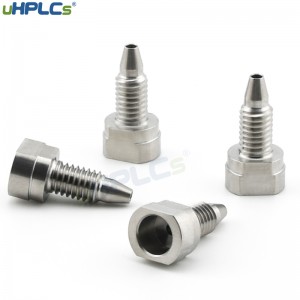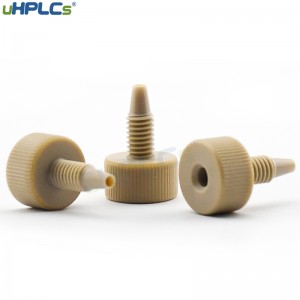Dead volume
Dead volume definition
The volume between the effective injection point and the effective detection point excludes the portion of the column containing the stationary phase. It consists of 4 parts:
- The volume of the inlet to the column line
- The gap between the stationary phase particles in the column (occupied by the mobile phase, Vm)
- The volume of the column exit line
- The volume of the detector flow cell
Only Vm is involved in the chromatographic equilibrium process, while the other 3 parts only play the role of peak expansion. To prevent peak expansion, the volume of these three parts should be minimized.
System dead volume is generally determined by feeding small molecules that are essentially not retained. Uracil, acetone and thiourea are the most commonly tested substances in reversed-phase chromatography; dead time is related to dead volume; it can be determined by dividing the dead volume by the flow rate.
Dead Volume Calculation
For HPLC, how to calculate the dead volume?
Dead volume (V0) – the space from the injector inlet to the mobile detector cell that is not occupied by the stationary phase. It consists of four parts:
- The volume of the inlet to the column pipeline
- The gap between the stationary phase particles in the column (occupied by the mobile phase, Vm)
- The volume of the column exit pipeline
- The volume of the detector flow cell
Only Vm is involved in the chromatographic equilibrium process, and the other 3 parts only play the role of peak expansion. To prevent peak expansion, the volume of these three parts should be minimized.
Dead time (dead time, t0) – the retention time of a non-retentive component. It is time for the mobile phase (solvent) to pass through the column.
The measurement of dead system volume is usually measured experimentally. The common method is to obtain a peak by feeding a needle into a special solution that does not affect the stationary phase of the column, from which the peak can be measured dead time (t0), which is the result of the actual measurement of t0.
Then the dead volume of the system is obtained by calculation:
Dead volume (V0) = dead time t0 × flow rate F of the mobile phase.
Reduce the dead volume
In the process of use or maintenance, if it involves the replacement of pipeline and other accessories, we should choose the accessories with the same specifications to ensure that the dead volume is the same as the original, to avoid the increase of dead volume and bring the spreading of peak shape.
When installing the column, make sure that the pipeline connectors are well-matched (pay special attention to the use of peeking tubing connectors and the connection between the pipeline and the column) to avoid the formation of joint cavities (as shown below).

So when should I choose which joint?
Stainless steel couplings are the best choice for reliable high-pressure sealing
pressure-type fittings with front and rear gaskets – for optimal sealing performance – available for all liquid chromatography systems on the market
PEEK (<400 bar system pressure) fittings are suitable for:
Frequently changed connections, e.g. for connecting different columns – Low-pressure requirements.
PEEK and polyketone couplings are suitable for connections that need to be changed frequently or when biocompatibility is required. The maximum operating pressure is 200 bar for PEEK fittings and 600 bar for polyketone fittings.
Definition of standing volume
The standing volume is the volume between the point of the first solvent mixing (usually in the liquid chromatograph’s mixing chamber or the proportioning valve) and the head of the liquid chromatography column. In this case, the standing volume of a low-pressure mixing system is equal to the sum of the volumes from the proportional valve through the pump and other system components to the column head. The standing volume of the high-pressure mixing system is equal to the sum of the volumes from the point where the solvent is mixed, through the two metering pumps, and then to the column head. In isocratic separations, the retention volume does not affect retention time, while in gradient separations, it can have a significant effect. Failure to understand the standing volume of the system can have serious implications, as the standing volume can be much larger than the column volume.

Same hplc column, different instruments
Suppose you want to use the same size column on different instruments. In that case, you often need to consider the issue of standing volume, as instruments with different standing volumes using the same method may also affect the analytical results. When starting the gradient elution at the head of the column, you need to ensure that the mobile phase volumes through the column are the same. The results will be different if the mobile phase volumes are not the same.
Suppose the same method is used in two labs for HPLC instruments with different residual volumes. In that case, the run results will likely not be identical because the two (or more) mobile phases mixed to form the gradient will take a different amount of time in each instrument’s flow path before reaching the column head. Therefore, the retention time and separation of the analytes will be affected by the time after injection, as they will pass through different mobile phase components. If the gradient method is transferred from one instrument to another, the retention time will change depending on the residual volumes of the two systems. The closer the flow path volumes are, the higher the agreement of the results.
Differences in results, if any, can be corrected using various methods. If the retention volume of the instrument is small, the retention volume can be adjusted by increasing the instrument’s volume; if the instrument’s retention volume is large, the inner diameter and length of the instrument connection line can be reduced. In addition, a gradient delay can be set in the method to compensate for the different residence times in the flow path system.
Delay Volume
Delayed volume refers to the volume between the solvent mixing point (usually in a liquid chromatograph’s mixing chamber or a proportional valve) and the LC column head.
The delayed volume is important to allow the column to complete the change in mobile phase composition as short as possible when the solvent composition changes for gradient elution or isocratic elution. Low-pressure mixture systems generally have a larger residence volume than high-pressure mixture systems.
Delay volume reduction
As the delay volume varies from instrument to instrument, it may impact the separation and retention time when running gradient methods and may also impact method transfer or validation. The larger the delay volume, the greater the potential impact. The larger the delay volume, the longer it takes to reach the column after changing the gradient ratio, especially at low flow rates.
There are three main approaches to reducing the effect of different retention volumes on separation effectiveness.
First (and best), some system controllers can inject the sample at a precise time after the gradient has started. If the injection time tD is delayed, the gradient and the sample can reach the column inlet simultaneously.
Second, suppose a period of the isocratic process can be inserted at the beginning of the gradient process. In that case, this process can be shortened with a system with a larger VD value and extended with a smaller VD value. In this way, the sample and the gradient will reach the column inlet at the same time.
Third, a steeper gradient from 5%B to initial %B is used.

Post time: Oct-15-2022








